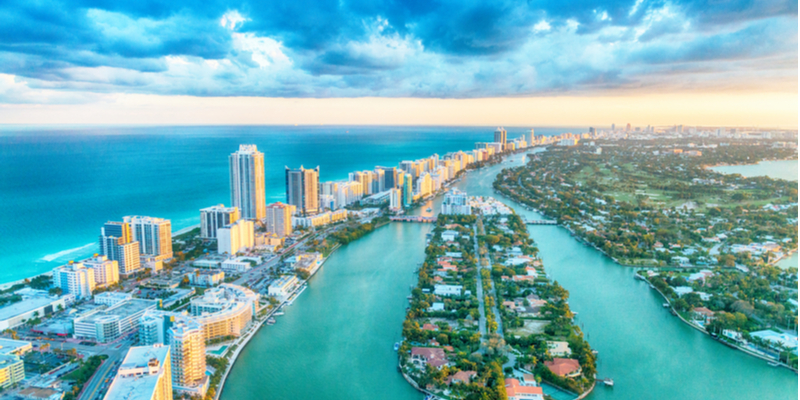There are strict in-building radio coverage requirements for buildings constructed in Miami Beach, Florida. First and foremost, to determine if a new building requires a radio coverage solution, the General Contractor or Owner must receive a preliminary assessment or baseline report of the in-door radio signal. This report must be produced by a qualified company, such as Highland Wireless.
The report will include details about floor plan, and radio signals throughout the premise, along with recommended changes to improve signal strength. A report should be produced before windows and doors are installed, and again after installation.
Qualifying the Designer & Installer
Construction tasks should be conducted to all of the standards outlined by OSHA safety and/or local safety regulations. Contractors are required to comply with related Federal, State and Local Codes and requirements, this includes Florida Building Code.
Important Industry Standards & Codes
- NFPA 1: National Fire Protection Association Fire Code
- NFPA 70: National Fire Protection Code or “National Electrical Code”
- NFPA 72: National Fire Alarm and Signaling Code
- NFPA 780: “Standard for the Installation of Lightning Protection Systems”
- Motorola R-56: “Standards and Guidelines for Communication Sites”
- TIA Bulletin TSB-88.1-C: Wireless Communication Systems Performance in Noise-Limited Situations, Part 1: Recommended Methods for Technology-Independent Performance Modeling
- Florida Building Code
- ANSI/TIA-222-G: Structural Standard for Antenna Supporting Structures and Antennas
- IEEE STD 142 “Green Book”: “Recommended Practice for Grounding of Industrial and Commercial Power Systems”
- ANSI/TIA/EIA-568-B: “Commercial Building Telecommunications Cabling Standard”
- ANSI/TIA/EIA-569-B: “Commercial Building Standards for Telecommunications Pathways and Spaces”
- ANSI/TIA/EIA-606: “The Administration Standard for the Telecommunications Infrastructure of Commercial Building”
- ANSI/TIA/EIA-607: “Commercial Building Grounding and Bonding Requirements for Telecommunications
- In addition to all other relevant Federal, State, and Local Building Codes and Requirements
Turn-Key Solution
The designer and/or installer must provide a “turn-key” solution for the design, installation and testing of in-building RF coverage system that meet all requirements. A minimum signal strength of -95 dBm is required for the downlink signal throughout the entire facility. The DAQ must measure 3.4 or greater and is mandatory at all times.
When it comes to Critical Areas, the in-building RF solution may provide coverage across 99% of building area.
Critical areas include mechanical and utility rooms, as well as public restrooms, elevators, stairs, and exits. In addition, they include Police holding areas, fire pump rooms, sprinkler sectional valve locations, elevator lobbies, elevator shaft, and any other area that is defined by the ruling agency. Critical areas must be confirmed before work may proceed.
Testing BDA uplink signal is not an easy task and involves taking measurements of the infrastructure of the Public Safety radio system. The completed system must offer full coverage in the frequency bands or channels as detailed by the ruling agency.
In Miami Beach, “the downlink and uplink frequency bands of the 800 MHz Public Safety signal booster are 851-861 MHz and 806-816 MHz, respectively.”
Signal Boosters
The signal booster is to be installed in a bright red NEMA 4 enclosure that locks. In addition, all power equipment must be stored in the same manner, with the capability of supplying at least four hours of emergency power supply.
The Exterior Antenna
The donor antenna must be high-gain, vertically polarized and specific to the operating frequency. Corner reflector-type or Yagi antennas are recommended.
In addition, the coaxial cable feed located outside of the building must be weatherized with a lightning protector.
In-Building Antennas
The in-building system must contain the appropriate number of antennas throughout the building, as well as in attached structures, so that coverage criteria is met. If using splitters or another type of active/passive component, it must be mounted in a separate 2 hour rated/fire resistant color yellow code junction box that is easy to access but out of harm’s way when it comes to unauthorized interference.
For a full list of requirements, codes and specifications: https://www.highlandwireless.com/wp-content/uploads/2017/07/CITY-OF-MIAMI-BEACHBDA-INSTALLMENT-GENERAL-GUIDELINES.pdf
At Highland Wireless, we make compliance easier than ever. We even offer free pre-testing of signal strength as well as site surveys. Learn more or contact us today to set up your consultation

